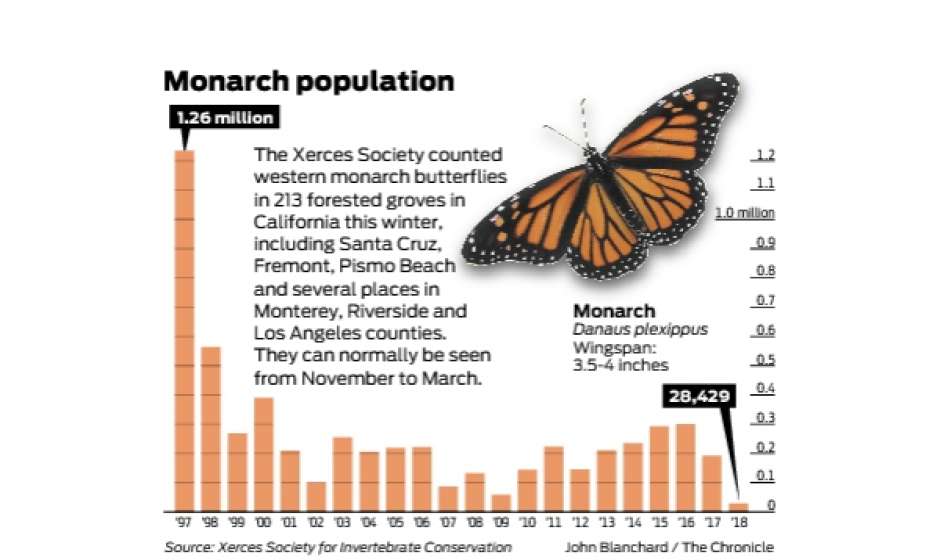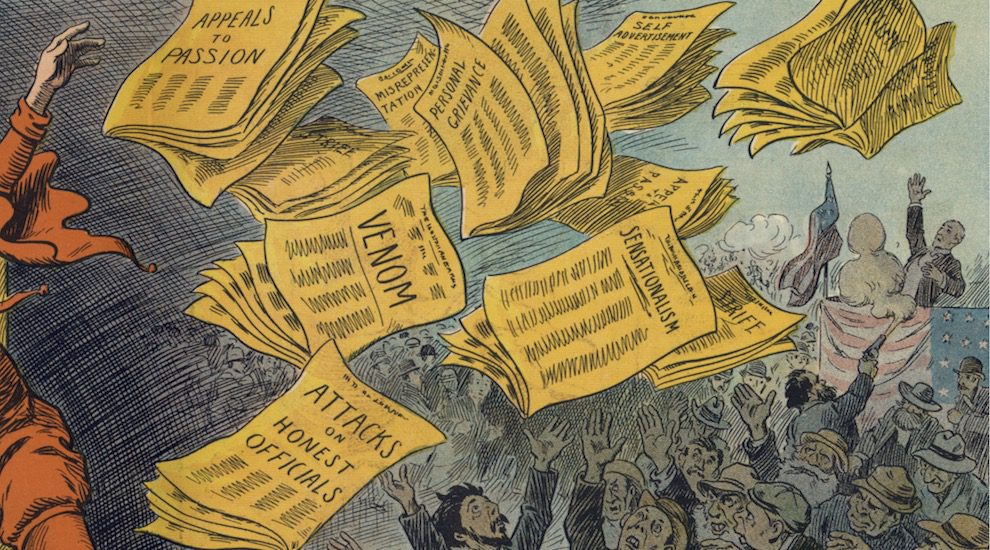California’s most famous butterfly nearing death spiral
An alarming, precipitous drop in the western monarch butterfly population in California this winter could spell doom for the species, a scenario that biologists say could also plunge bug-eating birds and other species into similar death spirals.
Only 28,429 of the striking orange-and-black butterflies were counted at 213 sites in California, an 86 percent drop from a year ago, according to the final tally of the annual Thanksgiving and New Year’s counts released Thursday by the Xerces Society for Invertebrate Conservation.
That’s a 99.4 percent decline since the 1980s, an all-time low for the Pacific Coast, where an estimated 10 million monarchs once blanketed trees from Marin County to the Baja California peninsula, providing, by all accounts, a spectacular winter display of color.

Scientists knew things were bad for the western monarch, but then “there was this other order of magnitude drop,” said Emma Pelton, a conservation biologist for the Xerces Society, an international nonprofit whose mission is to protect invertebrates and their habitats. “It’s mind-boggling. We’re now down below 1 percent of the historic population.”
The death of monarchs does not bode well for other insects, like bees, or bird species that make their living eating insects.
Monarchs in trouble
Western monarch butterflies spend the winter in more than 300 forested groves along the California coast, including large populations in Riverside and Los Angeles counties, Pacific Grove, Monterey and at Natural Bridges State Beach in Santa Cruz. They can normally be seen from November to March.
With the number of butterflies declining rapidly, here are four things governments and the public can do to help:
Protect and manage California overwintering sites.
Restore breeding and migratory habitat in California, particularly habitat along the coast range, foothills and Sacramento Valley.
Stop spraying pesticides and herbicides near milkweed, their primary habitat.
Protect, manage, and restore summer breeding and fall migration habitat outside of California.
“It is very apt to say this is a canary in a coal mine for a lot of our native pollinators,” Pelton said. “There’s a tight link in a loss of insects and our songbirds, which rely on insects. We have declines in songbirds, and I think that links directly to declines in insects.”
The die-off has been blamed on a variety of things, including urban sprawl, the spraying of pesticides and herbicides on corn and soybean crops, and the plowing under of the monarch’s milkweed habitat along their migratory route.
A University of Michigan experiment published in July found that higher carbon dioxide levels have reduced a natural toxin in milkweed that feeding monarch caterpillars utilize to fight off parasites. The study showed a 77 percent reduction in parasite tolerance in the butterflies hatched on milkweed grown under high concentrations of carbon dioxide, which comes from car and factory emissions and is what scientists say is the primary cause of climate change.
If nothing is done, Pelton said, the California butterflies, first observed by a Russian expedition looking for a passage across the Arctic Ocean in 1816, could be on an “extinction vortex,” a time when there are not enough butterflies left to recover.
Nobody knows how low the monarch population can go before it’s too late, but a 2017 study funded by The U.S. Fish and Wildlife Service and published in the journal Biological Conservation calculated that the point of no return would likely come when there are fewer than 30,000 butterflies.
The more abundant eastern monarchs, which spend their winters in Mexico instead of California, are famous because they cover whole sections of forest in a kaleidoscope of color. It is the largest insect migration in the world, but it too is in trouble. The eastern monarchs have declined more than 90 percent since 1996, when scientists estimated there were 1 billion nesting in the trees.
The journeys of both populations are remarkable in that it takes several generations of butterflies to make the six- to nine-month-long trek south for the winter. When they head back, starting in February or March, the mothers will die after laying eggs on milkweed, where the caterpillars grow up. Once they are ready to fly, the young butterflies somehow know where to go, without ever having even seen their mothers.
The California population is declining at an average of 7 percent a year, according to the 2017 Fish and Wildlife study. At the time, there were about 300,000 monarchs in California. That’s slightly worse than the 6 percent drop seen in the eastern monarch population.
“If this prediction is true, we are now below the quasi-extinction threshold,” Pelton said. “This is a crisis.”
There are two major migrations of monarch butterflies — the eastern and western populations — which scientists believe divide themselves at the Rocky Mountains when they head south for the winter from their summer homes in Canada and the Pacific Northwest.
In all, monarch populations in North America have plunged more than 95 percent since the 1980s, researchers have said.
Article via SFChronicle
Anti-vaxxers are among the WHO’s top 10 global health threats, and Ebola fake news is killing people
During an outbreak in the Democratic Republic of Congo, “as rumors surface, communications experts rebut them with accurate information via WhatsApp or local radio.”
Anti-vaxxers are one of the top 10 global health threats. The World Health Organization identified “vaccine hesitancy” — “the reluctance or refusal to vaccinate despite the availability of vaccines” — as one of its top 10 health concerns facing the world in 2019.
A 2018 study found that “philosophical-belief” vaccine non-medical exemptions have risen in 12 of the 18 states that allow them, and the authors noted:
While NMEs continue to rise in most of the 18 US states that allow them, several European countries, including France and Italy, as well as Australia, have taken measures to either make vaccines compulsory or even fine parents who refuse to vaccinate their children. Romania has experienced serious and large measles outbreaks and may also tighten vaccine legislation. Our concern is that the rising NMEs linked to the antivaccine movement in the US will stimulate other countries to follow a similar path. It would be especially worrisome if the very large low- and middle-income countries — such as Brazil, Russia, India, and China (the BRIC nations), or Bangladesh, Indonesia, Nigeria, and Pakistan — reduce their vaccine coverage. In such a case, we could experience massive epidemics of childhood infections that may threaten achievement of United Nations global goals.
Measles cases in Europe are at a 20-year high, The Guardian reported last month, topping 60,000 in 2018 per WHO — “more than double that of 2017 and the highest this century. There have been 72 deaths, twice as many as in 2017.” New York is facing its most severe measles outbreak in decades, with cases there concentrated almost exclusively among ultra-Orthodox Jews.
This week, Elsevier Atlas highlighted research that aims to help explain anti-vaccine attitudes. The study looked at the Dunning-Kruger effect — a form of cognitive bias in which people assume they know more than they actually do about an issue, or people’s “ignorance of their own ignorance” — surrounding vaccines. Matthew Motta, a postdoc at the Annenberg Public Policy Center at the University of Pennsylvania and is the lead author of of the study, explained:
We gave people a knowledge test about the causes of autism and then we asked people in a national survey: How much do you think you know about the causes of autism? We asked the same question about medical experts like doctors and scientists. We compared people’s perceptions of self to perceptions of experts and looked at that versus how well they scored on the knowledge test. We show there’s a relationship between knowledge and misinformation and what we call overconfidence — the belief that you know more. As we showed, those who are the least knowledgeable and most misinformed were most likely to exhibit overconfidence. Once we did that, we looked at policy implications of overconfidence. We looked at the correlation between attitudes, for example, about whether it should be required to vaccinate kids going to public school. Those who were the most overconfident were less likely to think that was the case.
The researchers, in a survey of 1,300 U.S. adults, found that “more than a third of study participants believe they knew as much as or more than medical doctors and scientists about the causes of autism,” and that while they trusted information from experts, they also “place high levels of trust on information from non-experts (42 percent) and feel that non-experts should play a major policymaking role (38 percent).”
“We need efforts to inform people, but we also need to debunk misinformation. Hitting people over the head with facts probably isn’t going to do that,” Motta said. “What it might look like is the subject of follow-up studies. That’s the key question: how can we combat misinformation about vaccines?”
“More transparent — in some cases literally.” In Science Magazine, author and science journalist Laura Spinney reports on how rumors and hoaxes are making the battle against an Ebola outbreak in the Democratic Republic of Congo more difficult — and how public health workers have launched an unprecedented effort to fight misinformation.
For the first time in an Ebola outbreak, UNICEF and other agencies have joined forces as a single response team, which answers to the DRC’s Ministry of Health and includes dozens of social scientists, who use the airwaves, social media, and meetings with community and religious leaders to fight misinformation. Responders also foster trust by making their work more transparent — in some cases literally. A new biosecure tent, called the Biosecure Emergency Care Unit for Outbreaks (CUBE), allows relatives to visit and see Ebola patients during treatment.
Here’s some of what the social scientists are doing:
Part of their role is to chart the social networks through which the virus spreads, but they also gather information about communities’ perceptions, which is entered within days into an online “dashboard” created by the International Federation of Red Cross and Red Crescent Societies (IFRC) in Geneva. The government has also recruited young people to report misinformation circulating on WhatsApp, a major information channel in the DRC, says Jessica Ilunga, a spokesperson for the DRC’s Ministry of Health in Kinshasa.
As rumors surface, communications experts rebut them with accurate information via WhatsApp or local radio. They take care not to repeat the misinformation; research has shown this is the best way to help the public “forget” false news and reinforce the truth. The vocal support of Ebola survivors has helped as well. Grateful for their care, some have become volunteers at Ebola treatment centers (ETCs).
And the BBC’s Yvonne McPherson, director of BBC Media Action USA, wrote in December about her work as BBC Media Action’s Ebola response efforts. There’s a difference, she explains, between “acute and chronic misinformation problems.” An example of an acute misinformation problem, for instance, was a 2014 rumor that you could avoid Ebola by bathing in salt water.
The salt water Ebola example was a real life case of acute misinformation in West Africa. News reports tracked this rumor to a text message from a student in Nigeria. It spread immediately to social media, with hundreds of tweets repeating the rumor in the following couple of days. In just as many days, the Nigerian Ministry of Health, the World Health Organization and others corrected it across traditional and social media, and the rumor was quashed. Sadly, this misinformation was responsible for at least two deaths and many people were hospitalized due to excessive consumption of salt water.
That’s an acute scenario: where misinformation spreads rapidly, then is corrected by multiple trusted sources and goes away.
But chronic misinformation is even trickier:
A chronic misinformation example would be the belief or suspicion that vaccines are harmful. It is chronic because this misinformation persists over years despite available facts to the contrary.
Algorithms, and the market forces underpinning them, are designed to capture attention, and in turn provide a breeding ground for misinformation to spread. Tweaking algorithms to direct people away from non-credible sources or annotating articles with credibility warnings may be part of a solution; however, these efforts do not address the longstanding beliefs people may already have about a health issue.
Article via niemanlab.org
Former Epic Records Intern Says R. Kelly Sexually Abused Her When She Was 16
In the wake of Lifetime’s bombshell R. Kelly documentary, another accuser is speaking out for the first time, claiming he also sexually abused her when she was a teenager. Tracy Sampson tells Dateline that Kelly allegedly abused her beginning in the summer of 1999 when she was 16 and working as an intern at Epic Records. She claims he forcibly kissed her then initiated a sexual relationship with her all while she was underage. Sampson told Dateline that Kelly asked her, “‘Can I kiss you?’ and I was like, ‘No,’” to which he responded, “‘Well, give me a hug.’ And then, like, when I gave him a hug he just started kissing me.” She continued, “I was in love with him. I just didn’t know what to do. Like, I didn’t know if this was normal. I didn’t know if this is how adults acted.”
Sampson says she ended the relationship after she turned 18 and then sued Kelly in 2001 for sexual abuse, including forcing her to receive oral sex from another woman. Kelly denied the allegations but settled with Sampson out of court for $250,000. Kelly has been accused by multiple women of sexual abuse throughout his 25-year career, many of whom told their stories in Surviving R. Kelly,and in 2017 was accused of holding women against their will as part of an alleged “sex cult.” Kelly’s lawyer tells Dateline now that all of Kelly’s accusers are lying, “every one of them.”
Article via Vulture
Grimes, Azealia Banks subpoenaed in lawsuit over Elon Musk’s bad weed tweet
In some very 2019 news, pop stars Grimes (née Claire Boucher) and Azealia Banks have been subpoenaed in the ongoing lawsuit over Elon Musk’s bad tweet. You remember the one: In August, he announced that he might be taking Tesla private at $420 a share, a figure that turned out to be a wildly miscalculated weed joke. Now, the SEC is suing him for misleading investors, and, due to their very public feud, the two artists may hold some key information.
See, it began with some now-deleted Instagram posts from Banks, who shared the sordid tale of a weekend with Musk and Grimes, his girlfriend. Banks was allegedly at his L.A. home to collaborate on a song with Grimes, but claimed she was ignored “while Grimes coddled her boyfriend for being too stupid to know not to go on Twitter on acid.” Guess which tweet that was! “I saw him in the kitchen tucking his tail in between his legs scrounging for investors to cover his ass after that tweet,” she later added in an interview with Business Insider. Banks added even more fuel to the fire when she shared encrypted Signal messages between her and Grimes, who bragged about introducing Musk to weed and noted that he’s “super entertained by 420” and set the price of his stock at 420 “for a laugh.”
The subpoenas won’t require Grimes and Banks to testify in court. Rather, they require the two to preserve any communications, online or otherwise, that could be considered evidence.
Musk, meanwhile, still has a Twitter account.
Article via AVClub
Judge rules against elderly lesbians rejected from retirement home
Bev Nance, 68, and Mary Walsh, 72, were denied an apartment in Missouri’s Friendship Village because their marriage is not “understood in the Bible.”
A federal court on Wednesday ruled against a lesbian couple who brought a lawsuit against a Missouri retirement home that rejected the women’s apartment application because their marriage is not “understood in the Bible.”
Bev Nance, 68, and Mary Walsh, 72, married a decade ago in Massachusetts and have been in a committed relationship for roughly 40 years.
When they applied to move into the Friendship Village senior living facility, they did so “because it is in their community, they have friends there, and it offers services that would allow them to stay together there for the rest of their lives,” said Julie Wilensky, an attorney representing the couple.
But once Friendship Village staff found that Nance and Walsh are married, they told the couple that they were not allowed to move in, because the home did not condone homosexuality. The letter they received said that the only married couples they accepted were those in unions between “one man and one woman.”
The couple sued, alleging “discrimination on the basis of sex,” and their case was finally decided this week by a federal court in Missouri, which found “sexual orientation rather than sex lies at the heart of Plaintiffs’ claims.”
LGBTQ groups decried the outcome, and the couple’s lawyers said “we disagree with the court’s decision, and our clients are considering next steps.”
Michael Adams, CEO of SAGE, which advocates for LGBTQ seniors, said, “This is sex discrimination, and it is against the law.”
“Mary Walsh and Bev Nance were discriminatorily denied admission to the Friendship Village retirement community for one reason only — because they are two women in a committed relationship rather than a woman and a man,” Adams told NBC News.
The couple’s lawyers made that argument in court: that because Walsh and Nance are women who are in a relationship with a woman instead of a man as is traditional, they would not have been prevented from moving in if their sex were male.
Judge Jean C. Hamilton, however, provided a different view of the case’s merits.
“At no time do Plaintiffs assert that had they been men involved in a same-sex relationship or marriage, they would have been admitted as residents in Friendship Village,” Hamilton wrote in the court’s decision. “Under these circumstances, the Court finds the claims boil down to those of discrimination based on sexual orientation rather than sex alone.”
Hamilton then dismissed the women’s claim, noting that the 8th U.S. Circuit Court of Appeals, which covers Missouri and other Midwestern states, ruled in 1989 that existing federal civil rights law “does not prohibit discrimination against homosexuals.”
The case Hamilton referred to, Williamson v. A.G. Edwards & Sons, is currently being challenged in court by the LGBTQ legal advocacy group Lambda Legal. The group is representing a man whose job offer was rescinded after the company found out he is gay. This case, Horton v. Midwest Geriatric Management, could be decided this year, and if the 1989 precedent is overturned, discrimination against LGBTQ people would become illegal at the federal level in all the states in the 8th Circuit: North and South Dakota, Nebraska, Minnesota, Iowa, Missouri and Arkansas.
The Supreme Court is also considering whether to take up one or several appeals court cases that address whether “sex” discrimination bans in federal civil rights law include discrimination based on sexual orientation and gender identity. There is currently a patchwork of mismatching laws across the U.S. regarding this issue.
Article via NBCNews
Rob Kardashian Admits to Liking Being Scratched by Women, Seeking $500K in Damages from Blac Chyna
Blac Chyna is using comments previously made by ex Rob Kardashian in a deposition to challenge his claim that she physically abused him and should pay hundreds of thousands of dollars in damages as a result. Among Kardashian’s comments is his admission that he enjoys “being scratched” by women.
The former couple, who are parents to 2-year-old daughter Dream Renée, allegedly got into a physical altercation in December 2016 in the home of Kardashian’s younger sister, Kylie Jenner. In September 2017, Kylie, 21, and her older brother, 31, sued Chyna, 30, for battery, assault and vandalism, alleging she attempted to choke Kardashian with an iPhone cord during a fight.
In the complaint, the siblings claimed Chyna made a “deliberate attempt to extort the Kardashian family for her own monetary gains,” adding that her decision to have a baby with the only KarJenner son was “nothing short of an outright fraud to shake down the family.”
Some 15 months later, on Jan. 18, 2019, Chyna filed documents, obtained by The Blast, which include evidence that bolsters her assertion that her ex-fiancé suffered “no physical injuries, no actionable psychological injuries” during the incident.
Some 15 months later, on Jan. 18, 2019, Chyna filed documents, obtained by The Blast, which include evidence that bolsters her assertion that her ex-fiancé suffered “no physical injuries, no actionable psychological injuries” during the incident.
The year after the alleged fight, in July 2017, the exes made headlines once again because Kardashian posted graphic and expletive-ridden content about Chyna on social media — including three naked photos — while accusing her of drug use, alcohol abuse and infidelity.
After his social media rampage, Chyna and her legal team accused him of violating California’s revenge porn laws, claiming in court documents obtained by PEOPLE at the time that he allegedly hit her and threatened to kill himself multiple times. A judge later granted her a set of restraining orders against her ex.
Kardashian, who denied the assault claims, and his family requested that the case be dismissed. According to court documents filed Dec. 27, 2017, in the Superior Court of Los Angeles and obtained by The Blast, Kardashian “generally and specifically denies each of the allegations” and claimed Chyna “did not suffer any injury or harm as a result of any conduct by [Kardashian].”
In a statement to PEOPLE in response at the time, Chyna’s attorney said, “We are confident that we will prevail on this motion and at trial.”
A judge recently granted Chyna a trial date in the case, set for Feb. 3, 2020, with pre-trial depositions of Khloé Kardashian, Kim Kardashian, Kris Jenner and Kylie to take place in the spring of 2019.
Article via People
Kelly Rowland Confirms New 2019 Album & Speaks On Solange’s “Genius”
She’s ready.
Kelly Rowland has confirmed her plans to roll out a new album in 2019. “This year! I said that last year. But I actually, really mean it this year,” she joked. It has been 5 years since the release of her last LP and her fans are clamoring for a new project, especially after her last single “Kelly” dropped in November. The creative process has been quite intense for the singer.
“This is by far the longest, most pressure-filled process ever, only because I know what it’s supposed to be and I have been so hard on myself. I know it. And it’s the first time I’ve said it out loud. I’ve been extremely hard on myself. But it’s definitely coming, and I’m more so excited about this project than anything else,” Rowland revealed during an interview with Billboard.
She focused on the youngest of the artistic family, saying that she would love to collaborate with the talented Solange again.
“I’m a huge fan,” she said. “I love her writing and how detailed and particular she is. I always wanted to figure out how the heck she has so many different layers of harmonies when she is constructing these vocals, and it’s so complex but simple. It’s genius,” she gushed. “It’s the genius in her genius mind that she has in there.”
The pair previously worked together on Rowland’s “Simply Deep” as well as other tracks on the record of the same name. Rowland would later make vocal appearances on Solange’s critically-acclaimed A Seat at the Table.
Article via HotNewHipHop
Beyoncé Drops Lawsuit Over “Feyonce” Merchandise
Beyoncé had sued a Texas company that sold items that said “He Put a Ring on It” and more
Beyoncé has voluntarily dropped a lawsuit against a Texas company that was selling unauthorized “Feyonce” merchandise, Reuters reports and Pitchfork can confirm. Beyoncé and her team filed the lawsuit back in April 2016, alleging that Andre Maurice, Leana Lopez, and their company Feyonce Inc. had willfully engaged in trademark infringement, unfair competition, trademark dilution, and more by selling merchandise that said “FEYONCÉ,” “He Put a Ring on It,” and more. Beyoncé’s team had been seeking unspecified damages from Feyonce Inc., et al. The case was officially dismissed today (January 17).
As Reuters notes, it is unclear from court documents if Beyoncé and Feyonce Inc. reached a settlement out of court. Pitchfork has contacted Andre Maurice and Leana Lopez, as well as attorneys for Beyoncé.
Article via Pitchfork
Check out Lovelyti’s video:











